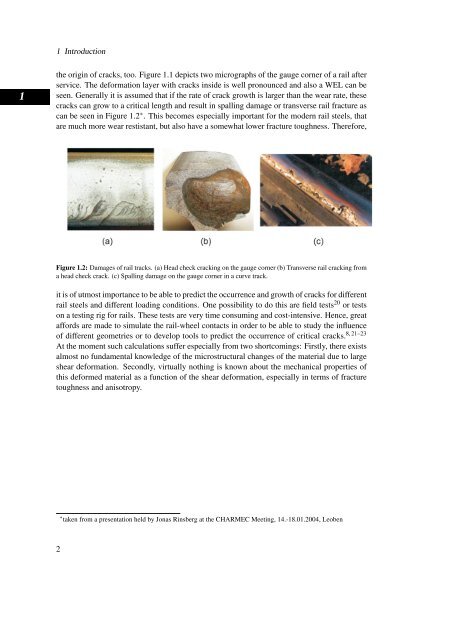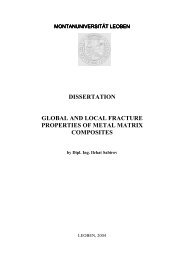Effect of Large Shear Deformation on Rail Steels and Pure Metals
Effect of Large Shear Deformation on Rail Steels and Pure Metals
Effect of Large Shear Deformation on Rail Steels and Pure Metals
You also want an ePaper? Increase the reach of your titles
YUMPU automatically turns print PDFs into web optimized ePapers that Google loves.
1<br />
1 Introducti<strong>on</strong><br />
the origin <str<strong>on</strong>g>of</str<strong>on</strong>g> cracks, too. Figure 1.1 depicts two micrographs <str<strong>on</strong>g>of</str<strong>on</strong>g> the gauge corner <str<strong>on</strong>g>of</str<strong>on</strong>g> a rail after<br />
service. The deformati<strong>on</strong> layer with cracks inside is well pr<strong>on</strong>ounced <strong>and</strong> also a WEL can be<br />
seen. Generally it is assumed that if the rate <str<strong>on</strong>g>of</str<strong>on</strong>g> crack growth is larger than the wear rate, these<br />
cracks can grow to a critical length <strong>and</strong> result in spalling damage or transverse rail fracture as<br />
can be seen in Figure 1.2 ∗ . This becomes especially important for the modern rail steels, that<br />
are much more wear restistant, but also have a somewhat lower fracture toughness. Therefore,<br />
Figure 1.2: Damages <str<strong>on</strong>g>of</str<strong>on</strong>g> rail tracks. (a) Head check cracking <strong>on</strong> the gauge corner (b) Transverse rail cracking from<br />
a head check crack. (c) Spalling damage <strong>on</strong> the gauge corner in a curve track.<br />
it is <str<strong>on</strong>g>of</str<strong>on</strong>g> utmost importance to be able to predict the occurrence <strong>and</strong> growth <str<strong>on</strong>g>of</str<strong>on</strong>g> cracks for different<br />
rail steels <strong>and</strong> different loading c<strong>on</strong>diti<strong>on</strong>s. One possibility to do this are field tests20 or tests<br />
<strong>on</strong> a testing rig for rails. These tests are very time c<strong>on</strong>suming <strong>and</strong> cost-intensive. Hence, great<br />
affords are made to simulate the rail-wheel c<strong>on</strong>tacts in order to be able to study the influence<br />
<str<strong>on</strong>g>of</str<strong>on</strong>g> different geometries or to develop tools to predict the occurrence <str<strong>on</strong>g>of</str<strong>on</strong>g> critical cracks.<br />
8, 21–23<br />
At the moment such calculati<strong>on</strong>s suffer especially from two shortcomings: Firstly, there exists<br />
almost no fundamental knowledge <str<strong>on</strong>g>of</str<strong>on</strong>g> the microstructural changes <str<strong>on</strong>g>of</str<strong>on</strong>g> the material due to large<br />
shear deformati<strong>on</strong>. Sec<strong>on</strong>dly, virtually nothing is known about the mechanical properties <str<strong>on</strong>g>of</str<strong>on</strong>g><br />
this deformed material as a functi<strong>on</strong> <str<strong>on</strong>g>of</str<strong>on</strong>g> the shear deformati<strong>on</strong>, especially in terms <str<strong>on</strong>g>of</str<strong>on</strong>g> fracture<br />
toughness <strong>and</strong> anisotropy.<br />
2<br />
∗ taken from a presentati<strong>on</strong> held by J<strong>on</strong>as Rinsberg at the CHARMEC Meeting, 14.-18.01.2004, Leoben
















